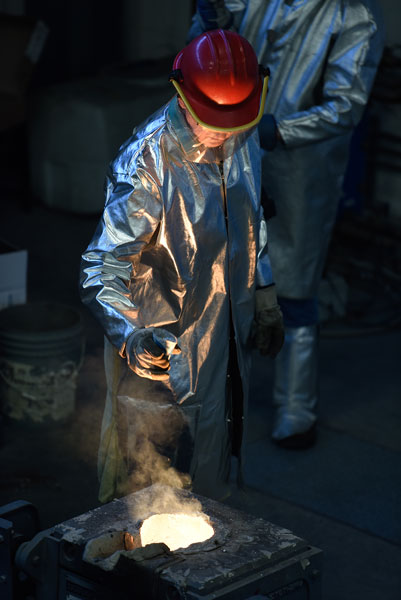GATE Center of Excellence
 The U.S. Department of Energy (DOE) awarded the MPAD more than $600,000 in funding as one of seven Graduate Automotive Technology Education (GATE) Centers of Excellence.
The U.S. Department of Energy (DOE) awarded the MPAD more than $600,000 in funding as one of seven Graduate Automotive Technology Education (GATE) Centers of Excellence.
mpad gate2The DOE FCVT goal states – “Development and validation of advanced materials and manufacturing technologies to significantly reduce automotive vehicle body and chassis weight without compromising other attributes such as safety, performance, recyclability, and cost.” The DOE GATE goal states - “To provide a new generation of engineers and scientists with knowledge and skills in advanced automotive technologies.” The UAB GATE project objectives are aligned with the overall DOE FCVT and the DOE GATE goals respectively and are to:
- Train and produce graduates with background and knowledge in automotive technologies with emphasis on advanced lightweight materials and manufacturing
- Produce top-quality graduates that will serve the growing automotive industries with knowledge in regulations such as CAFÉ standards, its economic and technical implications and next generation technologies that will help create fuel efficient high performing vehicles
- Advance the state of the art in science and application technology of cost-effective carbon fiber and its composites; predictive engineering and modeling for long fiber processes, ‘green’ and reduced carbon footprint materials, crashworthiness-injury biomechanics, lightweight metal castings
- Provide avenues for graduate students to specialize with a focus on automotive-related lightweight materials technologies with 14 GATE courses to choose from to obtain the GATE certificate
- To be a permanent education and training resource for the automotive and transportation industries (within and outside Alabama) that seek continuing education from academia for materials and manufacturing related courses
- Leverage growing automotive industry in the State of Alabama into educational aspects that will retain students in this industry
- Expand training avenues for educational institutions and industry by innovative web-accessible virtual classroom capabilities at UAB and tapping into its industry network
- Creatively integrate synergistic multi-departmental activities, by maintaining a focus on lightweight materials. This focus includes processing, process modeling and characterization of innovative lightweight materials, high-fidelity simulation and computational modeling, crashworthiness and injury reduction in the context of lightweight materials.
UAB GATE Courses
A student must take six courses in order to be awarded a GATE certificate. While each course is traditionally offered as a full-semester course, any of these courses can be shortened to a 2-3 day workshop format to suit industry needs.
Composite Design and Manufacturing Technologies for Automotive Applications
This course will cover basics of thermoplastic materials, avenues in automotive component designs, emerging processing technologies (LFTs, P4, thermoforming etc.), testing methodologies
Process Modeling and Simulation for Lightweight Materials
Castings and Composites; Simulation emphasis in lightweight cast metal parts, thermoplastic and thermoset processes such as resin transfer molding, P4, extrusion-compression molding etc.
Optimized Lightweight Material Designs for Prevention of Crash-Related Injuries
Relationships and design/optimization of lightweight materials in the context of injury prevention. Equal emphasis on biomechanics tied to automotive lightweight materials. Modeling, materials selection and design.
Mechanical Characterization and Performance Evaluation of Advanced Lightweight Materials
Test methods including traditional static testing combined with dynamic impact, low, high strain-rate and high velocity blunt and sharp object impacts, impact mechanics, fatigue, creep and environmental testing
Advanced Composite Mechanics
Lamination theory, traditional composite mechanics, viscoelastic properties, mechanics leading development of material models for LFTs, P4 and other emerging material combinations
Nanomaterials for Automotive Applications
Nanostructuring of castings, fibers, polymers and interfaces. Nanoclays, nanofibers and nanotubes in the context of automotive processing and design.
Process Quality Engineering
Statistics and quality aspects of process engineering such six sigma, design of experiments and materials handing.
Nondestructive Evaluation
Principles, applications and limitation of ultrasonic, vibration, acoustic emission, radiographic, magnetic particle, eddy current and other nondestructive testing methods. Intelligent sensors and health monitoring of real structures.
Carbon Fiber Technologies for Automotive
Carbon fiber production routes, reclaimed carbon fiber, textile grade carbon fibers, economic considerations, sizing studies, carbon fiber thermoset and thermoplastic composites.
Modeling and Simulation for Crashworthiness
Impact mechanics, finite element analysis, use of LS-DYNA and ANSYS software, case studies in material-body interactions, impact collisions modeling and analysis.
Sustainable/Renewable Materials and Processing Technologies for Automotive
Introduction to biocomposites, natural fibers and bioresins, science and development in sustainable materials, recycled materials and processes, case studies for automotive and heavy trucks
Predictive Engineering – Integrated Process Modeling and Design in Composites & Castings
Process modeling and Design Integration for carbon fiber composites and magnesium castings. Course will have significant software such as CADpress, Moldflow, Pro/Cast, Fluent and analysis content including experimentations with long fiber injection molding and casting
Materials by Design for Heavy Trucks and Mass Transit
Materials issues with heavy truck and mass transit industries, component weight reduction, role of materials in global mass transit and fuel, case studies for metal to composite replacement, magnesium and multi-material approach, assembly and joining methodology
Materials and Design for Fuel Cell and Hybrid Vehicles
Carbon fiber materials and intermediate forms for fuel cells, fuel cell design, long fiber thermoplastic processing of fuel cell elements, weight analysis and distribution, assembly and joining